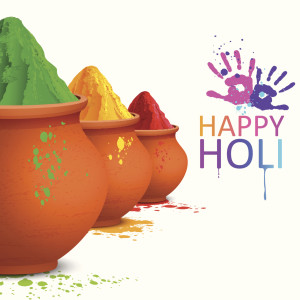
Who doesn’t want to say good-bye to winter and the cold? Spring brings sun, flowers, and fresh asparagus. Many cultures have a spring festival in March to celebrate the spring equinox. The Middle East observes Nowruz, the Persian New Year. In Japan, it’s called Shunbun no Hi. Families visit and clean up ancestral graves and enjoy a family reunion. Many countries celebrate Mother’s Day in March. In England, New Age practitioners make a trek to Stonehenge on March 21 to watch the first sunrise of spring. The Hindu festival of spring is called Holi.
Origins of Holi
King Hiranyakashipu, King of Multan, a city in Punjab, believed that he was indestructible and grew arrogant. His son, Prahlada, remained obedient to Lord Vishnu, which infuriated the King. The King punished Prahlada, to no avail. Eventually, the King’s sister, Holika took matters into her own hands. She tricked Prahlada into sitting on top of a pyre with her. The pyre burned and so did Prahlada, but Holika had a protective cape which was to keep her safe from the flames. In a strange turn of events, the cape blew off Holika and protected Prahlada. Holika died in the fire, while Prahlada survived. King Hiranyakashipu became angry and smashed a pillar. Lord Vishnu came to the party and killed the King. When the fire cooled, the people put ashes on their forehead.
Another legend tells the tale of love. Krishna, who had dark blue skin after being poisoned by a she-demon, fell in love with the fair-skinned Radha. Krishna felt self-conscious because of his skin color, and he was worried whether the girls would like him. Finally, his mother suggests that he approach Radha and ask to color her face any shade he desired. Radha accepts, and they became a couple. Love won over doubt. In the Braj region this legend explains the heritage of Holi.
The Significance of Symbolic Storytelling
Hindus have a rich heritage of symbolic storytelling. They use stories and myths to give examples of symbolizing the destruction of evil by good. Today, the Holi festival is significant because it not only marks the beginning of spring, which is thought to be the new year, but it also is a time to end conflicts and a day to forgive. People forgive themselves for their own errors and take the opportunity to start fresh.
In some places in India, Holi is celebrated for 16 days. The night before the celebration, they light bonfires to remember the defeat of Holika. In the following days, the children celebrate with colored powder sprays, covering their friends in a rainbow of beautiful shades. Adults get into the action by smearing colored powder on the faces of their friends and families. Food is served to visitors to the home.
Holi has inspired many events around the world in the spring, most significantly music festivals that revolve around color or marathons in which the participants are doused with pigment. Critics worry that these events ignore the cultural significance of the celebration. Holi is important in the Hindu tradition, and it shouldn’t be trivialized.
Honoring the Traditions of Storytelling
One way people can honor Holi, even though they may not be Hindu is to forgive and renew relationships in the spring. Just as many cultures celebrate spring, for generations, storytelling was the way to pass down history of the land and the family. In the 1920s, Sweden began a national day of storytelling in the spring. Other countries picked up on the tradition, and today it is an international celebration on March 21. The theme for 2016 is “strong women.” Take time to pass on the stories in your family about strong women and men who came before to make you the person you are today.

